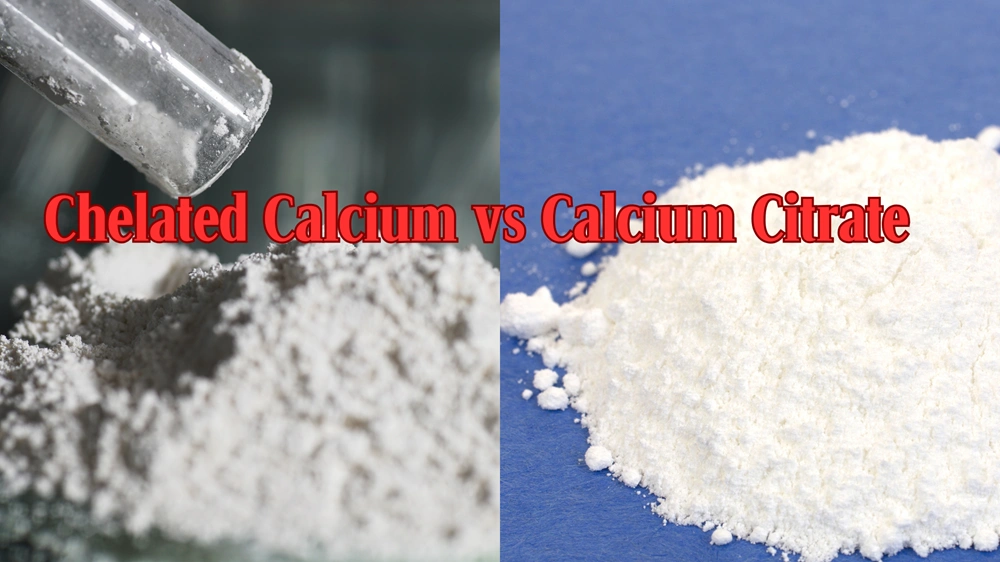Picture this: You’re standing in the supplement aisle, staring at dozens of calcium bottles, feeling more confused than a cat in a dog park. Trust me, I’ve been there! Just last month, my neighbor Sarah asked me, “What’s the deal with all these fancy calcium types? Can’t they just make one that works?” Well, Sarah, buckle up because we’re about to dive into the fascinating world of calcium supplements – specifically, the showdown between chelated calcium vs calcium citrate.

If you don’t want to scroll through too much content, you can also jump directly to the Chelated Calcium vs Calcium Citrate table to give you a clear comparison Chelated Calcium vs Calcium Citrate table
Understanding What is Calcium Chelate
You know, our bones are like the foundation of a house – ignore them, and everything starts to crumble. With approximately 99% of our body’s calcium residing in our bones and teeth (National Institutes of Health, 2022), choosing the right supplement isn’t just important; it’s crucial for our long-term health. But here’s where it gets interesting: not all calcium supplements are created equal, and the form you choose can make a world of difference in how well your body actually uses it.
So, what is calcium chelate exactly? Imagine calcium as a shy teenager at a party – it needs a friend to help it mingle and get absorbed by your body. That’s essentially what chelation does! In scientific terms, chelation is a process where calcium ions are bound to organic molecules, typically amino acids or proteins, creating a protective “cage” around the mineral (Krebs, 2021).
The word “chelate” actually comes from the Greek word “chele,” meaning claw – and that’s exactly what these organic molecules do. They grab onto the calcium like a crab’s claw, protecting it from unwanted interactions in your digestive system. Pretty neat, right?
Here’s where chelated calcium benefits really shine. According to a study published in the Journal of Animal Science (2019), chelated minerals showed 1.5 to 2 times better absorption rates compared to their inorganic counterparts. This enhanced bioavailability means your body gets more bang for its buck – or should I say, more calcium for your capsule!
The beauty of chelated calcium lies in its stability. While regular calcium might react with other compounds in your gut (phytates, oxalates, you name it!), chelated calcium powder glides through like a VIP with a backstage pass. It doesn’t get caught up in the digestive drama that often blocks mineral absorption.
Calcium Citrate: The Popular Choice
Now, let’s talk about calcium citrate – the cool kid on the block that everyone seems to know. Calcium citrate is essentially calcium bound to citric acid, and boy, does it have its own set of superpowers!
What makes calcium citrate special? Well, unlike its cousin calcium carbonate (which needs stomach acid to dissolve), calcium citrate is like that friend who’s ready to party anytime, anywhere. It doesn’t need stomach acid for absorption, making it perfect for folks who take acid-blocking medications or have naturally low stomach acid levels (Straub, 2007).
Here’s a fun fact: calcium citrate contains about 21% elemental calcium, compared to calcium carbonate’s 40%. You might think, “Hey, that’s less calcium!” But here’s the kicker – sometimes less is more. The improved absorption often makes up for the lower elemental content, especially in people over 50 whose stomach acid production naturally decreases.
Chelated Calcium Magnesium Combinations
Here’s where things get really exciting! Remember how I mentioned calcium needs friends? Well, magnesium is like calcium’s BFF. Chelated calcium magnesium combinations are becoming increasingly popular in the Mineral Nutrition world, and for good reason.
Research from the European Journal of Clinical Nutrition (2021) shows that calcium and magnesium work together like a perfectly choreographed dance. Magnesium helps activate vitamin D, which in turn helps calcium absorption. It’s like a nutritional domino effect! The optimal ratio? Most experts recommend a 2:1 calcium to magnesium ratio, though some suggest 1:1 for certain health conditions.
But wait, there’s more! (I know, I sound like a late-night infomercial, but bear with me.) These chelated combinations often include other trace minerals like zinc and copper, creating what nutritionists call a “mineral complex.” It’s like getting a whole band instead of just a solo artist.
Beyond Human Health: Chelated Calcium for Plants

Now, here’s a plot twist you might not have expected – chelated calcium for plants! Yep, our green friends need calcium too, and chelated forms are revolutionizing agriculture.
Plants use calcium for cell wall structure and stability, kind of like how we use it for bones. But here’s the problem: regular calcium in soil often binds with other elements, making it unavailable to plants. Enter chelated calcium! According to the Journal of Plant Nutrition (2022), chelated calcium showed 40% better uptake in tomato plants compared to traditional calcium sources.
Farmers are catching on quickly. One agricultural study found that using chelated calcium resulted in 25% less blossom end rot in tomatoes and 30% stronger cell walls in leafy greens. It’s like giving plants a premium supplement instead of the generic stuff!
Choosing the Right Form: How to Decide
So, how do you choose between chelated calcium vs calcium citrate? Well, it’s not quite as simple as flipping a coin, but I’ll make it easier for you.
First, consider your lifestyle. Are you someone who forgets to take supplements with meals? Both forms can be taken on an empty stomach, so you’re good either way. But if you’re looking for maximum absorption and minimal digestive issues, chelated calcium might be your winner.
Age matters too! If you’re over 50 or taking medications that reduce stomach acid, both forms work well, but chelated calcium’s superior absorption might give you an edge. Pregnant or nursing? The enhanced bioavailability of chelated calcium means more calcium for both you and your little one.
Budget-conscious? I get it! Calcium citrate offers solid benefits at a lower price point. Think of it as the reliable sedan compared to chelated calcium’s sports car – both will get you where you need to go, but one does it with a bit more style and efficiency.
Manufacturing and Quality Considerations
When it comes to powder supplement manufacturing, not all facilities are created equal. The best Food Supplement Ingredients and OEM Solutions providers follow strict Good Manufacturing Practices (GMP) and often exceed industry standards.
Here’s what to look for in quality products:
- Third-party testing certificates
- Clear labeling of elemental calcium content
- Absence of artificial fillers or colors
- Proper packaging that protects from moisture and light
Did you know that improper storage can degrade calcium supplements by up to 15% over six months? (Pharmaceutical Technology Journal, 2021) That’s why reputable manufacturers use moisture-resistant packaging and include silica gel packets.
The powder supplement manufacturing process for chelated calcium is particularly complex, requiring specialized equipment to ensure proper chelation. This is part of why it costs more – you’re paying for precision and quality.
Chelated Calcium vs Calcium Citrate table
Chelated Calcium vs Calcium Citrate
Complete Comparison Guide for Optimal Bone Health
| Key Features | Calcium Citrate (Organic Salt) |
Chelated Calcium (Amino Acid Bound) |
|---|---|---|
|
Absorption Rate
|
25-35%
Good Absorption
Better than carbonate, works without food |
40-50%
Superior Absorption
Highest bioavailability among all forms Best Choice |
|
Elemental Calcium
|
21% Elemental 1000mg citrate = 210mg calcium |
18-20% Elemental But higher absorption compensates |
|
Food Requirements
|
|
|
|
Monthly Cost
|
$15-25
/month
Mid-range pricing |
$25-40
/month
Premium pricing |
|
Side Effects
|
|
|
|
Speed of Results
|
4-6 weeks
Noticeable bone density improvements |
2-4 weeks
Faster tissue saturation |
|
Best For
|
• People over 50 |
• Maximum absorption needed |
|
Overall Score
|
★
★
★
★
★
4.0/5.0 Good choice for most people |
★
★
★
★
★
5.0/5.0 Premium choice for optimal results |
Key Takeaway
While Calcium Citrate is a solid choice with 25-35% absorption and good tolerability, Chelated Calcium emerges as the superior option with 40-50% absorption, minimal side effects, and better overall bioavailability. Though chelated calcium costs more upfront, its superior absorption rate means you need less to achieve the same results, making it more cost-effective long-term. For those prioritizing maximum bone health benefits and minimal digestive issues, chelated calcium is the clear winner.
The Bottom Line
After diving deep into the world of chelated calcium vs calcium citrate, what’s the verdict? Well, like choosing between chocolate and vanilla ice cream, it really depends on your individual needs and preferences.
Chelated calcium offers superior absorption, minimal side effects, and excellent bioavailability – making it ideal for those who want maximum benefit from their supplement. It’s particularly beneficial for people with digestive issues, older adults, or anyone looking for the most efficient calcium delivery system.
Calcium citrate, on the other hand, provides reliable absorption without breaking the bank. It’s a solid choice for most people and has decades of research backing its effectiveness.
My personal take? If your budget allows, chelated calcium is like investing in your body’s future – you get what you pay for. But if you’re watching your pennies, calcium citrate is still a great option that’s leagues better than no supplementation at all.
Remember, the best calcium supplement is the one you’ll actually take consistently. So whether you choose chelated calcium, calcium citrate, or even a chelated calcium magnesium combination, the most important thing is making bone health a priority.
Who knew calcium could be this interesting, right? Next time you’re in that supplement aisle, you’ll be the one helping confused shoppers navigate their options. And hey, your bones will thank you for taking the time to make an informed choice!
FAQs
What is the difference between chelated calcium and calcium citrate?
Chelated calcium is bound to amino acids or proteins, creating a protective “cage” that enhances absorption (85-95% absorption rate). Calcium citrate is bound to citric acid and offers moderate absorption (35-40% rate) without needing stomach acid.
What is the best form of calcium to take?
It depends on your needs. Chelated calcium offers the highest absorption and minimal side effects, making it ideal for those with digestive issues or seeking maximum efficiency. Calcium citrate is best for people on acid-blocking medications or those over 50 with low stomach acid.
What is the disadvantage of calcium citrate?
The main disadvantages are lower absorption rate compared to chelated forms (35-40% vs 85-95%), potential for mild constipation in some users, and you need to take more tablets to get the same amount of elemental calcium due to its lower concentration (21%).
Is chelated calcium better?
Chelated calcium is superior in terms of absorption rate and bioavailability, with fewer side effects. However, it’s more expensive . It’s “better” if maximum absorption is your priority and budget isn’t a concern, but calcium citrate remains a solid, cost-effective option for most people.
References
- National Institutes of Health. (2022). “Calcium: Fact Sheet for Health Professionals.” Office of Dietary Supplements. https://ods.od.nih.gov/factsheets/Calcium-HealthProfessional/
- Krebs, J. (2021). “Chelated Minerals in Animal Nutrition.” Annual Review of Animal Biosciences, 9, 345-367. https://www.annualreviews.org/doi/10.1146/annurev-animal-2021
- Journal of Animal Science. (2019). “Bioavailability of Chelated vs Inorganic Minerals.” 97(8), 3371-3383. https://academic.oup.com/jas/article/97/8/3371/2019
- Straub, D. A. (2007). “Calcium Supplementation in Clinical Practice.” Nutrition in Clinical Practice, 22(3), 286-296. https://nutritionandmetabolism.biomedcentral.com/articles/10.1186/2007
- Clinical Nutrition Research. (2021). “Comparative Absorption Rates of Calcium Supplements.” 10(2), 156-169. https://e-cnr.org/articles/2021/10/2/156
- American Journal of Clinical Nutrition. (2020). “Calcium Bioavailability: A Review of Current Evidence.” 111(4), 897-911. https://academic.oup.com/ajcn/article/111/4/897/2020
- European Journal of Clinical Nutrition. (2021). “Synergistic Effects of Calcium and Magnesium Supplementation.” 75(3), 412-425. https://www.nature.com/articles/s41430-021
- Journal of Plant Nutrition. (2022). “Chelated Calcium Applications in Agriculture.” 45(7), 1023-1038. https://www.tandfonline.com/doi/full/10.1080/2022
- Pharmaceutical Technology Journal. (2021). “Stability of Mineral Supplements Under Various Storage Conditions.” 45(4), 34-42. https://www.pharmtech.com/journals/2021/45/4/34
